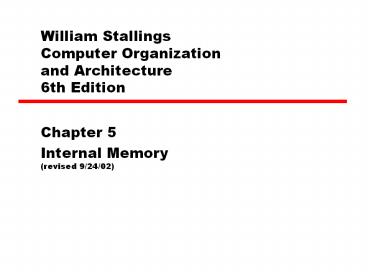William Stallings Computer Organization and Architecture 6th Edition - PowerPoint PPT Presentation
Title:
William Stallings Computer Organization and Architecture 6th Edition
Description:
William Stallings Computer Organization and Architecture 6th Edition Chapter 5 Internal Memory (revised 9/24/02) * * Semiconductor Memory Types Semiconductor Memory ... – PowerPoint PPT presentation
Number of Views:299
Avg rating:3.0/5.0
Title: William Stallings Computer Organization and Architecture 6th Edition
1
William Stallings Computer Organization and
Architecture6th Edition
- Chapter 5
- Internal Memory(revised 9/24/02)
2
Semiconductor Memory Types
3
Semiconductor Memory
- RAM
- Misnamed as all semiconductor memory is random
access - Read/Write
- Volatile
- Temporary storage
- Static or dynamic
4
Memory Cell Operation
5
Dynamic RAM
- Bits stored as charge in capacitors
- Charges leak
- Need refreshing even when powered
- Simpler construction
- Smaller per bit
- Less expensive
- Need refresh circuits
- Slower
- Main memory
- Essentially analogue
- Level of charge determines value
6
Static RAM
- Bits stored as on/off switches
- No charges to leak
- No refreshing needed when powered
- More complex construction
- Larger per bit
- More expensive
- Does not need refresh circuits
- Faster
- Cache
- Digital
- Uses flip-flops
7
SRAM v DRAM
- Both volatile
- Power needed to preserve data
- Dynamic cell
- Simpler to build, smaller
- More dense
- Less expensive
- Needs refresh
- Larger memory units
- Static
- Faster
- Cache
8
Read Only Memory (ROM)
- Permanent storage
- Nonvolatile
- Microprogramming
- Library subroutines
- Systems programs (BIOS)
- Function tables
9
Types of ROM
- Written during manufacture
- Very expensive for small runs
- Programmable (once)
- PROM
- Needs special equipment to program
- Read mostly
- Erasable Programmable (EPROM)
- Erased by UV
- Electrically Erasable (EEPROM)
- Takes much longer to write than read
- Flash memory
- Erase whole memory electrically
10
Error Correction
- Hard Failure
- Permanent defect
- Soft Error
- Random, non-destructive
- No permanent damage to memory
- Detected using Hamming error correcting code
11
Interleaved Memory
- Collection of DRAM chips
- Grouped into memory bank
- Banks independently service read or write
- requests
- K banks can service k requests simultaneously.
- Increasing memory read or write rate by a factor
of k
12
Hamming Error-Checking Code
13
Error Checking Overhead
14
Error Correcting Code Function
15
Advanced DRAM Organization
- Basic DRAM same since first RAM chips
- Enhanced DRAM
- Contains small SRAM as well
- SRAM holds last line read (c.f. Cache!)
- Cache DRAM
- Larger SRAM component
- Use as cache or serial buffer
16
Synchronous DRAM (SDRAM)
- Access is synchronized with an external clock
- Address is presented to RAM
- RAM finds data (CPU waits in conventional DRAM)
- Since SDRAM moves data in time with system clock,
CPU knows when data will be ready - CPU does not have to wait, it can do something
else - Burst mode allows SDRAM to set up stream of data
and fire it out in block - DDR-SDRAM sends data twice per clock cycle
(leading trailing edge)
17
IBM 64Mb SDRAM
18
SDRAM Operation
19
Rambus DRAM
- Adopted by Intel for Pentium Itanium processors
- It has become the main competitor to SDRAM
- It has a vertical packages with all pins on one
side - Data exchange over 28 wires lt cm long
- Bus addresses up to 320 RDRAM chips and rated at
- 1.6Gbps
- It delivers address and control information
using asynchronous block protocol - After an initial 480ns access time. This produces
the 1.6 GBps data rate.
20
RAMBUS Diagram
21
Double-Data-Rate SDRAM(DDR SDRAM)
- SDRAM can only send data once per clock
- Double-data-rate SDRAM can send data
- twice per clock cycle
- Rising edge of the clock pulse and falling edge.
- Fig.5.15 shows the basic timing for the DDR read
22
(No Transcript)
23
Cache DRAM
- It developed by Mitsubishi.
- Integrates small SRAM cache (16 kb) onto generic
DRAM chip - Used as true cache
- - 64-bit lines
- - Effective for ordinary random access
- To support serial access of block of data
- - refresh bit-mapped screen
- - CDRAM can prefetch data from DRAM into
SRAM - buffer
- - Subsequent accesses solely to SRAM































